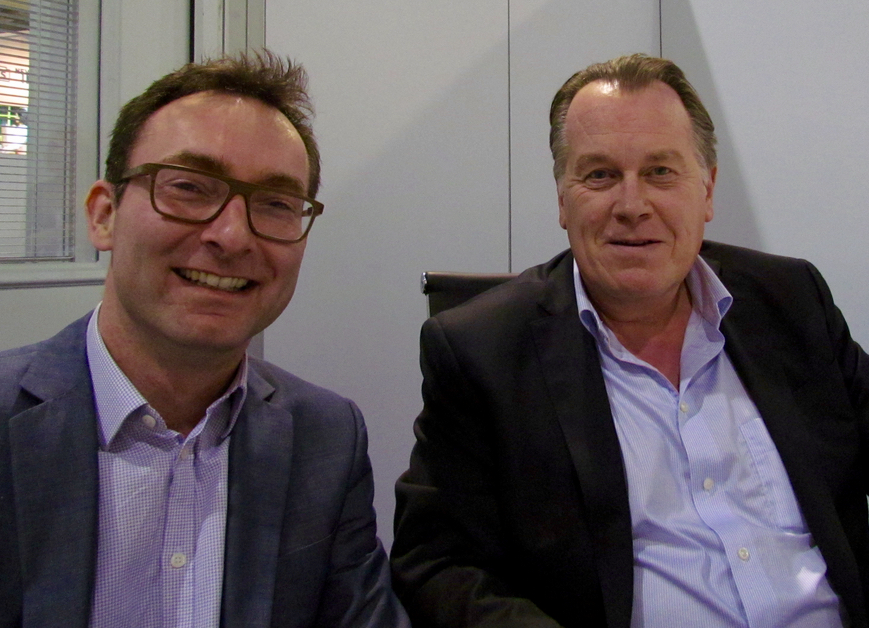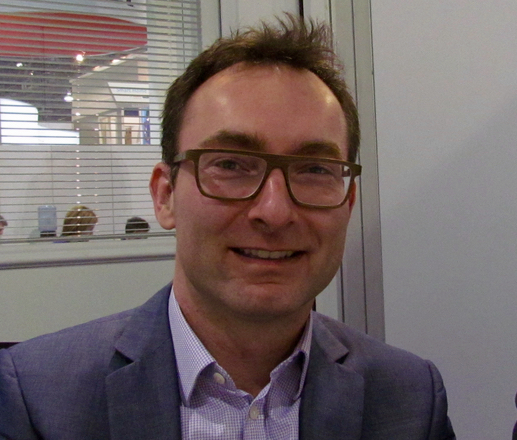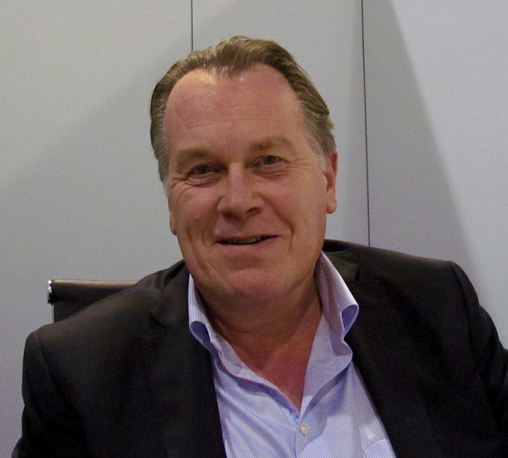Earlier this year we sat down for a direct chat with the two top executives at Ultimaker to find out what they’re up to.
We spoke with Ultimaker CTO Siert Wijnia (on the left above) and brand new CEO Jos Burger (on the right) about their roles, the company’s focus and Ultimaker’s secret plans.
Part 1 of this interview with the leaders of Ultimaker is available here.
Fabbaloo: A lot of new machines in the past two years are resin-based and we have seen huge interest in them. For example, Carbon3D somehow raised over USD$100M. Do you view that as a challenge or an obstacle to overcome?
Siert Wijnia: It is an interesting field, however the resin- based technology is a different ballpark and, for example, a lot of our machines go to the education market and they do not want to fiddle around with all these resins. Some of them are toxic.
We focus on materials that are non toxic and we try to promote non-toxic materials, like “use this one instead of that”.
We do see all these these new printers coming up like Carbon3D, but if they raise that much money, I don’t know. What we do know is that the material world is now waking up to the 3D printing scene and a lot of FDM segment is coming up / maturing big time. I think three or four years ago NatureWorks told me “apparently our 4042 plastic is being used for 3D printing!” So they weren’t engineering it for 3D printing! Now all of these big companies are engineering materials for 3D printing.
Jos Burger: The 3 main use cases for what 3D printers are best used for: 1) Prototyping, 2) Tooling is becoming bigger by the day and 3) Small Series Manufacturing. Low volumes, high margins. Difficult to make otherwise and customizable.
Ultimaker is perfectly positioned the deliver the promise. What we see happening now is more and more customers are basically gathering print farms, like 50-100 printers, and the quality of the outcome is defined by the software managing those printers. So we also put in a lot of effort in improving our software in order to handle the print farms. What people are doing then, is pushing out 100 pieces of the same kind or it’s one model exploded into 100 pieces, which they assemble. That kind of stuff.
People are really standardizing on FDM. We also see in chains, big companies standardizing on 3D printers – we are well positioned there, but they also push it down the chain to their suppliers. We see all kinds of proof models coming up around FDM. Materials are getting better by the day. There is still a lot to gain.
Fabbaloo: You explained that your customers are engineers. But there are also consumers and I have observed a kind of “collapse” in the consumer market, or perhaps companies just ran out of DIY people to sell to. How important is the consumer market to Ultimaker? Are you focusing less on consumers now?
Siert Wijnia: I think the consumer markets is related to the market we are getting towards right now. If you look at how these machines are sold and entering these big companies there is an engineer who says that it is too much hassle to buy an industrial 3D printer from a company, however the Ultimaker price tag is right so I may buy one myself. He brings it to the company and it kicks up from the bottom up and everyone realizes it is working.
Jos Burger: We did quite a thorough analysis of the different use groups lately and we mainly did this in Europe and the US. The US is quite important because it represents 35% of our revenues, and if you take it all together, in the US 30% is education and mainly higher education (all engineers) and 65% are businesses in the US and the remaining 10-15% are prosumers.
Those are people buying a printer for at home for specific purpose, but in 90% of these cases, they are the same engineers using them at work. So it is a matter of definition. What is a Consumer? Consumers are still people that have engineering skills. And it makes sense. You need to be able to produce a model and design a model in SolidWorks, Rhino3D or Onshape or AutoCAD. You need to understand how to tweak the 3D model in order to get a specific outcome from the print. It is always engineers doing that.
Fabbaloo: You guys don’t have a booth this year at the Consumer Electronics Show. Does that mean that you are no longer a Consumer product?
Jos Burger: Ya. Well. There are two angles to it. You can say we still say that we serve 10-15% of the market of consumers but knowing that they are engineers we know that there are so many better ways to get to these people. For instance, the huge SolidWorks event in Texas at the end of January with 6,000 engineers from all over the world will be there. And that is a far better way for us to reach out to our market.
Fabbaloo: Any hints of what we might see in 2016?
Jos Burger: <Laughs> People will kill me if I am too specific. We are working on a lot. There are two elements to it. People always talk about the next big thing. In our case it is more like continuous improvement of the machine. Some things are under the hood and people don’t see it, but it improves the quality of prints. If you talk about WiFi networking, dual extrusion, those are bigger things. But we will be on par with competition.
Fabbaloo: You have been CEO for 6 months, are you still having fun?
Jos Burger: Oh man. I have done a lot in my life and this is one of the most exciting companies. It is a roller coaster. Fantastic market. Fantastic people. And extremely rewarding. If you listen to the customer, they smell that something is going on. They embrace it, they work with us on new printers, on improvements. This is great fun. It is such a great company.
Siert Wijnia: I am really glad to have Jos in his role. He is really good at it. There is no hierarchy in the company.
Jos Burger: I don’t even have an office. I don’t have a desk. No really, I have a laptop. We have a great office with corners where people can drink coffee and I just have my Macbook Air and I go around. It works very well. Trust me. No office for me. I love it you know.
Siert Wijnia: That is why I really think Jos is the right guy.
It is about the product and the product isn’t even what is most important; It is what people make with the product that our focus is. I think that the fact that we are a human level organization, we try to be human on a personal basis. Whether the customer is in the US or in China, we are really trying to be normal.
Jos Burger: We quite often get visitors. Two months ago our own bank came by with 10-12 people. Stiff guys, we sat down and gave a presentation. We walked down the corridor explaining our company and exposing them to R&D. While we were explaining a guy came skateboarding down the corridor going back and forth. The CEO of the bank said, “Did you see that?” “Oh ya, that is (name), he made a 3D printer and he is testing it with a motor.” The bank CEO was so enthusiastic he said that they should do that too at their head office in Amsterdam. “We can give it a try.”
Siert Wijnia: The beauty of this is that it just happens. It is how we deal with people.
Fabbaloo: The strength of the company is often the strength of the people. It sounds like you guys are doing the right things.
Jos Burger: That is also one of the most challenging parts because we grow like hell, now to close to 200 people and you want to make sure that the new people are aligning with the DNA of the company and that is a tough one, of course.
Also in the US we are quite careful. We now have four or five people onboard in the 3D printing industry that you may know, and we will expand to 15-20 people. We want to make sure that they also align. It works out well.
Fabbaloo: It is a very careful approach, and that is how you succeed.
Siert Wijnia: In the end the one that is using the printer is a person, and the one making the printers is also a person. It is people that are doing it. People make a difference in the company. And I think that is number one.
It is about people.




